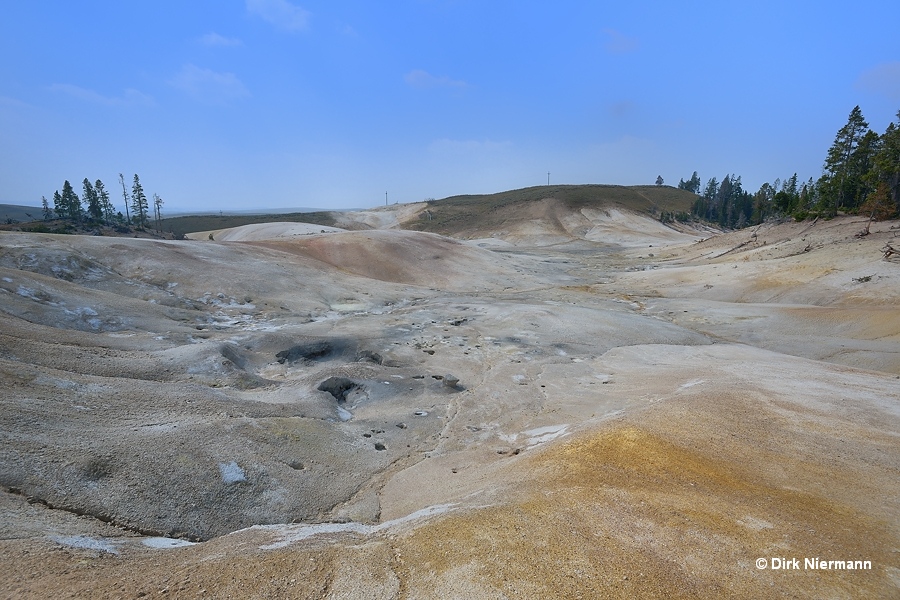Crater Hills Group
On a map Crater Hills looks like quite easy to reach. It is located 4.5 km (2.8 miles) northwest of the Mud Volcano area and only 1 km ( 0.6 miles) west of the Main Loop Road through Hayden Valley. This area is much frequented by bison and bears, though, and the thermal group can't be spotted from the highway due to a low ridge of hills flanking the road. If you drive northbound, wait until the ridge rises west of the road and then pick one of the next four roadway turnouts. Follow one of the game paths uphill as long as it roughly leads west and no bison are close. If bison show up, it needs a sufficient detour. In the event of a bear encounter stick to the recommendations of the National Park Service. Standing on top of the ridge, the bare ground of Crater Hills should come into view, otherwise you may have drifted too far to the north or the south.
The thermal area is bordered by two almost bare rhyolite hills in the northeast, which probably contributed to the placename. By exploring the backcountry setting you should take a lot of care because a huge number of fumaroles and small springs make the ground trappy.
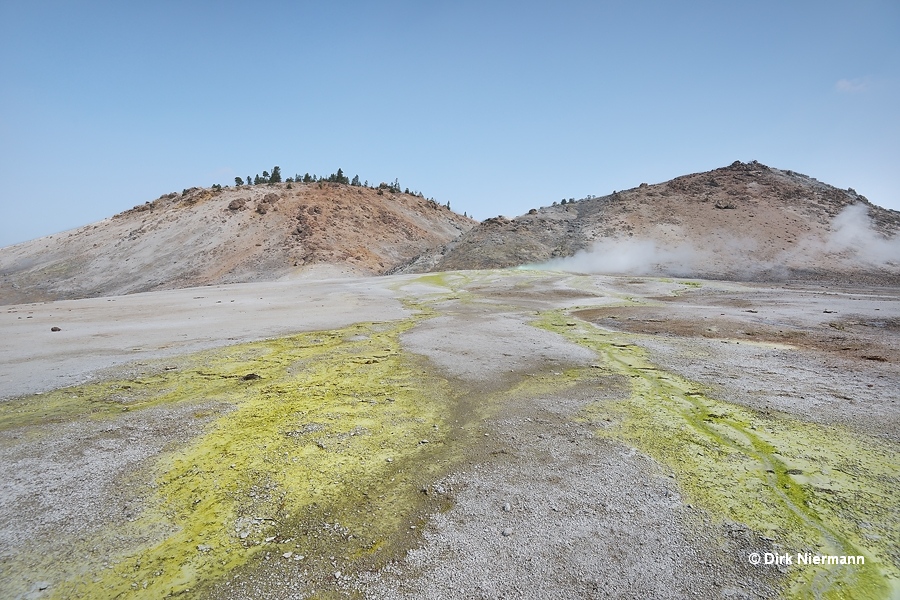
At the hill's southern foot lies Crater Hills Geyser. Officially, it is called Sulphur Spring, a fitting, but less distinctive name. Before 1920 the main tourist route through Hayden Valley ran close to the geyser and made it popular. In particular its bowl, measuring 6 m (20 feet) in diameter, was famous for its decorative rim. Like roots of an age-old tree its studded sinter extensions spread into the surroundings. After rerouting the road, the place quickly got out of sight from the public and became a seldom visited backcountry destination.
Crater Hills Geyser used to contain vivid blue, slightly clouded water. So on our visit in August 2015 we were very surprised to find the water intensely green tinted due to a high concentration of elemental sulfur. The walls of the pool were coated by a brilliant yellow sulfur lining, just as the runoff channels. While usually the geyser's water is confined to the inner, deeper bowl, we saw it surging also in the shallow outer basin with a significant overflow to the outside. During the two hours of our visit the spring erupted continuously, but it is known to have quiet intervals.
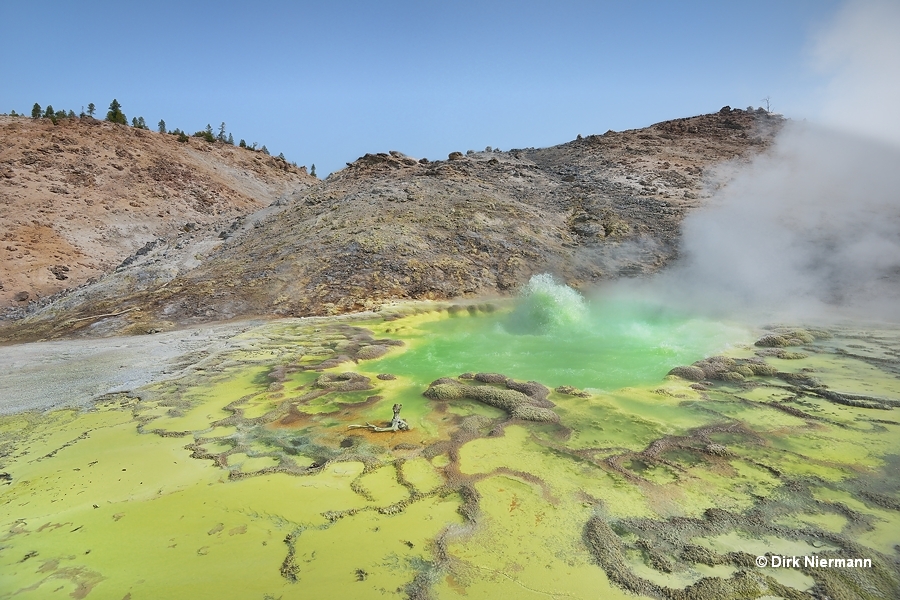
An early report makes it probable that this kind of sulfur enrichment has already been observed in the past. In The Diaries of John Gregory Bourke Volume 4: July 3, 1880--May 22, 1881 the following passage about the geyser is to be found: "... a hill of pure sulphur at whose foot bubbles the "Devil's Coffee Pot", a seething, hissing caldron of molten sulphur and hot steam, around whose edges is a deposit of clean, pure, canary colored brimstone." If "molten sulphur" does translate into "suspended sulfur", then a sulfur push, a shift between almost transparent clear water and a massive clouding by sulfur particles, has occured to Crater Hills Geyser not for the first time.
Ten years earlier on the Washburn-Langford-Doane Expedition, Lieutenant Gustavus C. Doane reported clear water in Crater Hills Geyser, as cited by geologist Albert C. Peale in the Preliminary Report of the United States Geological Survey of 1871: "The basin is built up with a solid rim or lining of pure crystalline sulphur (?) 4 feet in width all around the edge, probably amounting to 40 tons in weight. The water is clear, but of a whitish cast, and above the boiling point, steam being evolved from its surface. The basin cannot be approached nearer than 20 feet distant on account of the scalding vapors. A small channel leads down the slope, and for several hundred feet its bed is incrusted with a sulphur deposit, showing that the spring occasionally flows a considerable quantity of water. The deposit is from 3 to 10 inches deep."
The same applies for the description given by Ferdinand V. Hayden in his 1872 report: "On the south side of these hills, close to the foot, is a magnificent sulphur spring. The deposits around it are silica; but some places are white, and enameled like the finest porcelain. (...) It may be compared to a huge caldron of perfectly clear water somewhat superheated. But it is the decorations about this spring that lent the charm, after our astonishment at the seething mass before us — the most beautiful scalloping around the rim, and the inner and outer surface covered with a sort of pearl-like bead-work. The base is the pure white silica, while the sulphur gave every possible shade, from yellow to the most elegant cream. No kind of embroidering that human art can conceive or fashion could equal this specimen of the cunning skill of nature."
It is conspicuous that both sources emphasize the prominent sulfur deposits inside and around the pool, which apparently have disappeared during the decades after the 1880s. That huge amount of elemental sulfur may have been the reason for naming it Sulphur Spring.
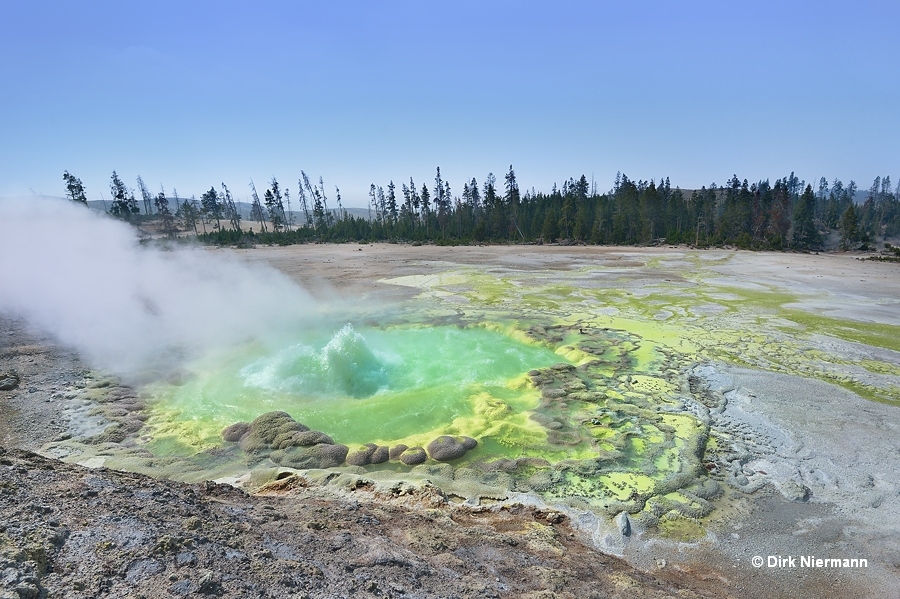
The observed sulfur discharge into the geyser's water reflects the complexity of the hydrothermal system. In contrast to all the other, acidic hot springs on location, Eugene T. Allen and Arthur L. Day detected alkaline water in Crater Hills Geyser and assumed that choride rich, alkaline water from the deep mixes with acidic, sulfur rich inflow from higher levels (Allen and Day, Hot Springs of the Yellowstone National Park, 1935). In 1989 Robert O. Fournier even suggested that Crater Hills Geyser represents the most direct leakage of up to 300 °C (570 °F) hot deep water all over Yellowstone (Fournier, Geochemistry and Dynamics of the Yellowstone National Park Hydrothermal System, 1989). The mixing hypothesis would easily explain why in August 2000 acidic conditions were determined for the blue water, as listed in the RCN Database. The changes on Crater Hills Geyser remind of Evening Primrose Spring in the Sylvan Springs Group, another "cocktail shaker" where a similar, even more dramatical shift ocurred at some point between 1900 and 1926. Subsequently, in 1970 or 1971 the spring got populated by Sulfolobus archaea and turned to a murky yellow-brown appearance. It is to be hoped that this does not happen to Crater Hills Geyser.
Following the hill's foot farther west, the boiling spring CHANN025 appears. Earlier reports and the RCN database show it as a clearwater spring, but, as with Crater Hills Geyser, we found a sulfur enrichment.
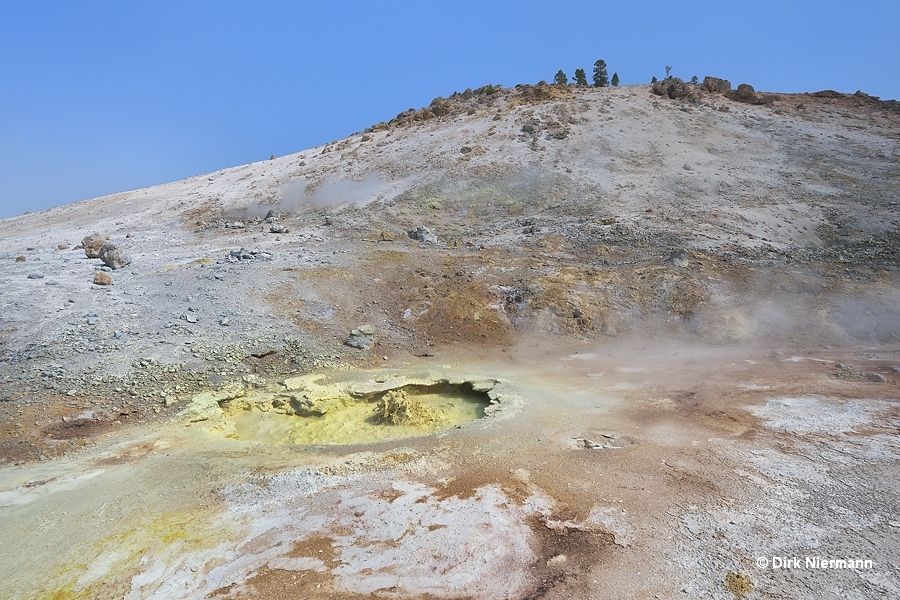
Another remarkable feature lies on the plain south of CHANN025. This perpetually spouting spring contains bluish gray water, clouded by sulfur compounds.
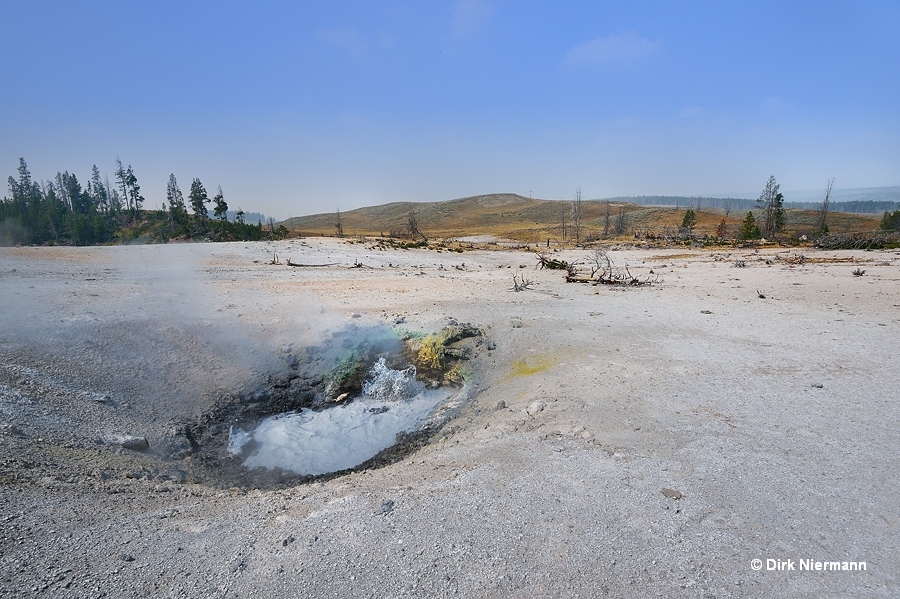
The largest spring on location is called Turbid Blue Mud Spring. It is no geyser, but shows pronounced turbulences and is bubbling constantly. As to be seen on the far righthand side of the next picture, the runoff from Crater Hills Geyser is abundant enough to discharge into Turbid Blue Mud Spring.
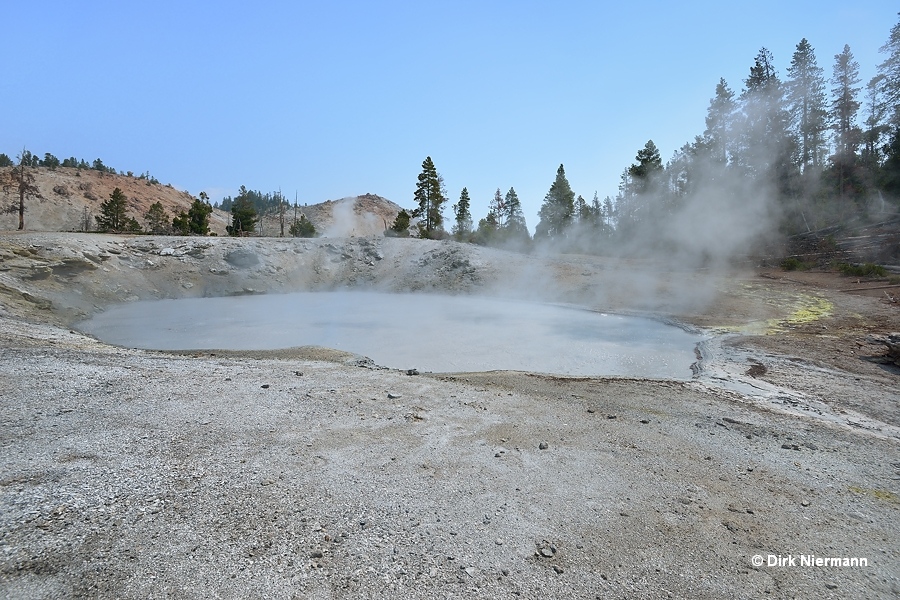
All in all, there are only very few named features in the Crater Hills Group. Alice Springs, southwest of Turbid Blue Mud Spring, carries at least an informal name. Unfortunately, we could not explore this section due to a herd of bison, which stood their ground firmly. Of course, we did not dare to disturb them. The last photo shows the southern part of Crater Hills, where Blue Mud Pot and Foam Spring are to be found.
